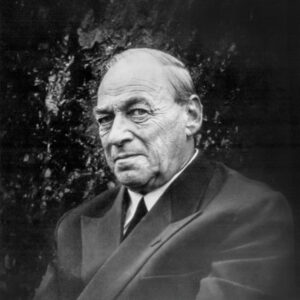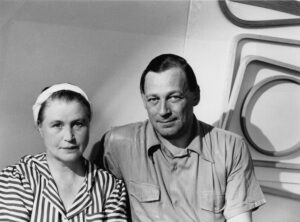
Vintage closed-frame armchair with zebra fabric, c. 1933
Alvar Aalto is regarded as Finland’s most famous architect. He not only used his talents to create beautiful buildings, but also to design beautiful furniture.

Vintage table with L-leg, c. 1935
In 1933, Aalto invented a new form of laminated bent-wood called the “L-leg.” He considered this L-leg design his greatest achievement. These legs could be attached directly to tables, chairs and stool tops. He wanted to create in wood what the modernists created with metal tubing.
 Aalto Vase / Savoy Vase, c. 1936
Aalto Vase / Savoy Vase, c. 1936
Aalto was also an esteemed glass designer, and his most famous work in glass is the Aalto or Savoy vase. He said he was inspired by a mud puddle.

Vintage 2-tiered, closed-frame table, c. 1930s
“All the time, even daily, whenever I walk into Aalto’s masterpiece, I have a sensation of breathing fresh air; similar to reading a book on French cooking, or Japanese raku pottery.” – Br. Claude Lane, O.S.B., monk of Mount Angel Abbey

Fan leg tripod stool, c. 1950s
Aalto is the undisputed master of Nordic Modernism. With the establishment of his studio in the early 1920s, Aalto’s architectural practice quickly embraced the developing international styles.

Tripod stool 60, black linoleum top, c. 1934
Aalto believed that architecture must sit comfortably within its natural landscape, replicate its forms, and use its materials. Nowhere is that more evident than in his furniture, textile and lighting designs, of which the simple, almost naïve-looking “60 Stool” is perhaps one of the most famous.

Vintage pair of hallway chairs, c. 1932
“Aalto’s building itself and everything in it of his design holds you quietly and peacefully in place and asks of you a similar level of
excellence in your own time within his space.” – Abbot Jeremy Driscoll, O.S.B., monk of Mount Angel Abbey

Entry Door Handles. Mount Angel Abbey Library, 1970
“Beauty is the harmony of purpose and form.” – Alvar Aalto

Vintage cantilevered chaise with “spring leaf support,” c. 1937
Aalto was one of the first to deviate from the stiff geometry of the early modern movement and to stress informality in a simple and humane style.

Armchair, black leather upholstery, c. 1940s
“God created paper for the purpose of drawing architecture on it. Everything else is, at least for me, an abuse of paper!” – Alvar Aalto

Vintage Y-Leg table, c. 1930s
Aalto’s style is regarded as organic, lyrical, and even romantic. He achieved an international reputation through his more than 200 buildings, ranging from factories to churches to libraries and an array of simple and appealing furniture designs.

Vintage tea trolley 900, c. 1937
Alvar Aalto’s lifetime conversation with nature, architecture, design and the human being has become a living legacy. His style became known as humanist modernism.

Curved study area overlooking the mezzanine
The Mount Angel Abbey Library is one of the most outstanding examples of the lyrical architecture of Aalto’s later years.

Stool with fan-Leg, c. 1935
“The Mount Angel Abbey Library is an elegant and humane space which readies the heart and mind for learning.” – Fr. Nathan Zodrow, O.S.B., monk of Mount Angel Abbey

Vintage upholstered armchair, c. 1932
Aalto “shunned the role of prophet and was averse to the abstract hair-splitting practiced by art critics today.” Instead, he was “a social creature,” whose “gift of doubt” set him apart from pontificators of all eras. (Schildt, Alvar Aalto: The Mature Years, 1991)

Mount Angel Abbey Library mezzanine today
“Work hard in silence, let your success be your noise.” – Alvar Aalto



 Alvar Aalto, a Finnish architect and designer, was part of the Modern Movement of Architecture. He created his own style as an interpretation of modernism, focused on local materials and functionality. He emphasized the use of wood to provide warmth to his projects and a stronger connection with local culture.
Alvar Aalto, a Finnish architect and designer, was part of the Modern Movement of Architecture. He created his own style as an interpretation of modernism, focused on local materials and functionality. He emphasized the use of wood to provide warmth to his projects and a stronger connection with local culture. Aalto’s most important collaborator was Aino Marsio-Aalto (1894–1949) his wife and professional partner. Alvar and Aino, married in 1924, were such close collaborators that it is impossible to determine each individual’s specific contributions to the work. (Schildt, Alvar Aalto: The Mature Years, 1991)
Aalto’s most important collaborator was Aino Marsio-Aalto (1894–1949) his wife and professional partner. Alvar and Aino, married in 1924, were such close collaborators that it is impossible to determine each individual’s specific contributions to the work. (Schildt, Alvar Aalto: The Mature Years, 1991) A new library at Mount Angel Abbey and Seminary became a pressing need in the 1960s. As the number of books grew, the available space became totally inadequate. Slowly, the monastic community began to heed Abbot Damian Jentges’ visionary call for a new library. In 1962 Abbot Damian authorized Fr. Barnabas Reasoner, O.S.B., librarian, to conduct a search for an architect to build a library that could become a cultural center for the Pacific Northwest. In response, Fr. Barnabas contacted several noted architects and secured one of international note, Alvar Aalto, of Finland. To the surprise of many, Aalto said yes to the invitation. (Rippinger, Struggle and Ascent: the history of Mount Angel Abbey, 2020)
A new library at Mount Angel Abbey and Seminary became a pressing need in the 1960s. As the number of books grew, the available space became totally inadequate. Slowly, the monastic community began to heed Abbot Damian Jentges’ visionary call for a new library. In 1962 Abbot Damian authorized Fr. Barnabas Reasoner, O.S.B., librarian, to conduct a search for an architect to build a library that could become a cultural center for the Pacific Northwest. In response, Fr. Barnabas contacted several noted architects and secured one of international note, Alvar Aalto, of Finland. To the surprise of many, Aalto said yes to the invitation. (Rippinger, Struggle and Ascent: the history of Mount Angel Abbey, 2020)

 Aalto Vase / Savoy Vase, c. 1936
Aalto Vase / Savoy Vase, c. 1936











